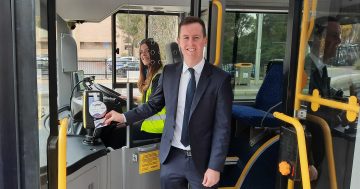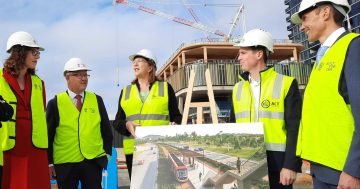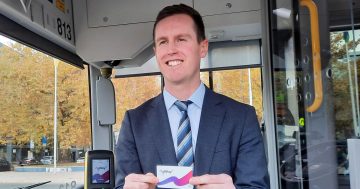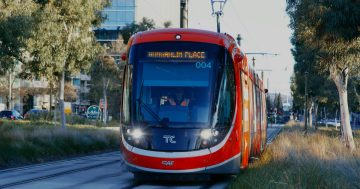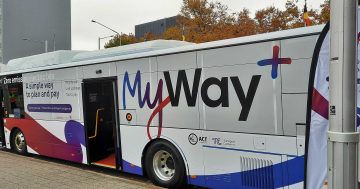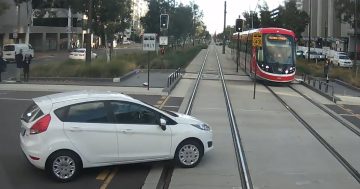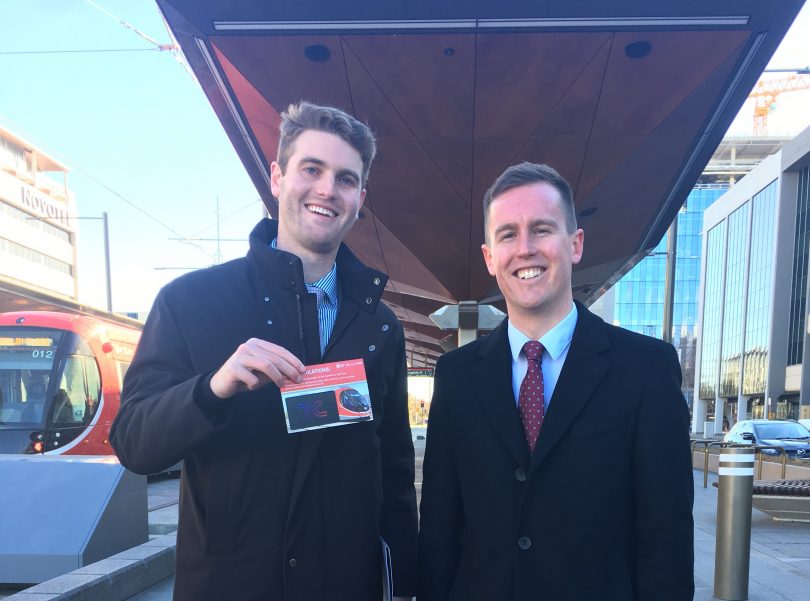
Millionth light rail user Jordan Bradfield with Transport and City Services Minister Chris Steel. Photo: Supplied.
Canberra’s new light rail system has carried its millionth passenger as Transport Canberra reported growth in commuter numbers across the entire public transport network compared with last year, since full-fare services commenced.
To celebrate the light rail milestone, the Minister for Transport and City Services, Chris Steel visited the Alinga Street stop this morning to present lucky passengers with a free MyWay card with $20 credit to use for journeys across the network, including the millionth passenger, Jordan Bradfield.
Mr Bradfield said he had been a regular bus user and it was great to have the light rail going.
“I get it to work, it’s 15 minutes, it’s cheap, it’s easy, it’s fantastic to see that Canberra has a real piece of public transport infrastructure now,” he said.
“Hands down it’s an easier commute than I am used to, and it’s a lot faster than I thought it would be, I think there are fewer cars on the road now.”
Mr Steel said success of the service spoke for itself with patronage numbers for light rail higher than anticipated in the business case for the first year of operation.
“We now have record numbers of Canberrans using public transport, exceeding expectations,” Mr Steel said.
“As time goes on with operations, the data is becoming clearer, Canberrans are choosing to use light rail and more public transport,” he said.
The Minister is still examining commuter feedback from the new bus network which included a stream of complaints about inconvenient route changes or losses, but any adjustments are expected to be minor.
Transport Canberra said light rail had generated a significant uptake in public transport use in the Gungahlin to the City corridor, with 32 per cent more public transport journeys starting in Gungahlin in June 2019 than there were in June 2018.
“Patronage growth in the inner north has also been very strong, with light rail now accounting for 20 per cent of all passengers on Transport Canberra services, and we expect this number to continue to grow as the urban renewal projects along the corridor are completed,” Mr Steel said.
Since the completion of free travel, weekday journeys across the whole transport network to 30 June 2019 had increased by 6.1 per cent compared with the same time last year and weekend journeys had increased by 32.7 per cent.
“The number of people using weekend services is incredibly high with more services in the evenings and more convenient services with the same route and number seven days a week,” Mr Steel said.
“Overall the signs are very positive for the new network. With more services, coming more often we are seeing more people moving on public transport compared to this time last year.”

32 per cent more public transport journeys are now starting in Gungahlin in June 2019 than there were in June 2018. File photo.
Ninety-five per cent of journeys being made were using MyWay cards, up from 89 per cent, with over a million journeys planned online using the new Journey Planner.
The Public Transport Association of Canberra said one million passengers on light rail was a tremendous achievement in such a short time since the service started operating, and proved that the claims public transport lobbyists had been making about light rail were correct.
“There are more people using light rail than there were bus passengers, fewer cars on the road, less congestion and a much more attractive Northbourne Avenue. This is all due to light rail being built,” Chair Damien Haas said.
“After years of public transport lobbying, this is a significant achievement and the early immediate success justifies that effort. Gungahlin and all of Canberra benefit from this first stage of light rail.”
He said the teething problems had been relatively minor, and the PTCBR was looking forward to seeing passenger data on bus services feeding the light rail stations.
Mr Haas said that the success of Stage 1 supported the case for light rail Stage 2 between Civic and Woden to be built sooner rather than later.
The Government has split the Woden route in two, hoping that the first section from Civic to Commonwealth Park can be approved quickly, while the more problematical second section across the lake and through the Parliamentary Zone can start later.
Both sections have been referred to the Commonwealth under the Environment Protection and Biodiversity and Conservation Act.













